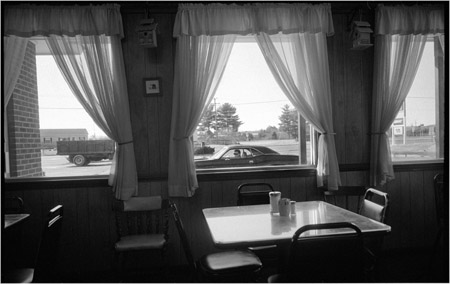
Diner and Suspense
Matt Weber’s photograph of a 1978 Challenger viewed from inside a diner is a perplexing, almost ominous scene. Why’s the car moving so slowly? Why’s the diner empty? Where is everyone?
Many writers think suspense is created by withholding information. They plant a seed on page 36 and tell me the information comes on page 90. But I’m not feeling suspense. I’m feeling frustration.
Suspense created by withholding information is sort of true but mostly not true. Because almost all information is withheld anyway.
The information Weber could about this diner scene is infinite. The chemical composition of the road outside. The origin of the fabric from which the driver’s shirt is made. The wage earned by the person who ran the cutting machine that cut the fabric. The height of the person who designed the button that fastens the shirt. The color of the hair of the captain of the freighter who brought the shirt closer to market. The name of the partner of the truck driver who delivered the shirt from dock to warehouse.
Eventually all that IS could be connected to this photograph. Because we live in a uni-verse which means everything is somehow connected to everything else. But these aren’t Weber’s questions.
We create suspense by knowing the primary question we want to raise. Our work doesn’t have to answer the question. It has to create the experience of living with the question. Weber’s photograph is art because he knows the question he wants to raise. And it isn’t about the color of the linoleum on the diner’s floor.
Suspense is core to everything we write. Not just thrillers. So we need to know what our primary question is for this work.
In our first one-to-one phone session as a client reads I notice the word “curve” appears 4 times in 7 pages. I’m thinking of developmental matters, and paying attention to language, so I mention this. His voice changes. Lowered and subdued, he speaks about the regimentation of his family culture. Everything standing at attention. Everything in straight lines. A whole world suddenly opens up and none of it is on his pages. I wonder if this material, not what’s on the page, contains the story that he alone can write. If this is where his real question lives. So I ask him about this.
The second misconception is that action creates suspense. On its own, it doesn’t. Unless it’s connected somehow to the deeper question it’s clutter. Noise.
Fact is our question can be felt in almost zero action. Consider Proust’s character dipping a madeleine into a cup of tea in his multi-volume novel In Pursuit of Lost Time.
When we start out our big question is, more likely than not, hidden from us. We’re not conscious of it. So we work with that un-fun feeling. But we trust and work anyway because uncertainty is necessary for the production of all art. It’s necessary in mathematics, in every branch of science, in parenting. Necessary in every form of love.
When we finally get to our real question, our work takes off. We can then shape our text around the pursuit of that question. The breakthrough is profoundly joyful.
We keep working. We get a question or a remark from a friend or editor or fellow-writer that takes us right to our question. Finally! Then we shape our suspenseful arc. We refine. We finish. We send out. We publish. A reader says she couldn’t stop reading. It made them miss their BART stop. Another texts he’s on silent retreat but read the first page and is weeping. These precious gifts. These are the responses we live for.
Exercises:
- Forget your current project. What’s your primary question, right now?
- Sit with your character in this diner. What’s he or she distracted by? Worried about? Fantasizing about? Happy for? Perplexed by? Write quickly. Fill 10 pages. See what you get.
Contact maryrakow1@gmail.com
©Mary Rakow, 2023. Please do not reproduce without written permission from the author. Copyright ©2023 Mary Rakow, Ph.D.